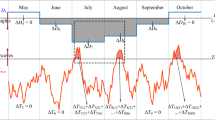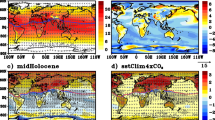Abstract
A popular perception is that landfalling tropical cyclones help to mitigate droughts in the Southeastern United States (SeUS). However intriguing paradigms on the role of large scale SST variations on continental US including SeUS droughts and seasonal Atlantic tropical cyclone activity confronts us. These paradigms suggest that in the presence of warm (cold) eastern tropical Pacific and cold (warm) Atlantic Ocean sea surface temperature anomaly (SSTA) lead to the increased likelihood of wetter (drier) conditions over the continental US including the SeUS. Juxtaposing this understanding with the fact that landfalling tropical cyclones contribute significantly to the annual mean total rainfall in the SeUS and in El Niño (La Niña) years with cold (warm) tropical Atlantic SSTA lead to reduced (increased) Atlantic tropical cyclone activity raises a conflict on the role of the large-scale SST variations in SeUS hydroclimate. This study attempts to investigate the apparent dichotomous role of the large scale SST variations on the SeUS hydrology by examining the role of rainfall from landfalling tropical cyclones in the SeUS to local seasonal droughts. Our study finds that the contribution of the rainfall from landfalling tropical cyclone on the mitigation of monthly drought in the 28 SeUS watersheds is relatively insignificant. So much so that the hydrological model uncertainty in estimating the drought index over the 28 SeUS watersheds is larger than the sensitivity exhibited by the drought index to the inclusion of rain from landfalling tropical cyclone. The conclusions of this study are justified by the fact that the timing of the landfalling tropical cyclone in relation to overall soil moisture conditions of the watershed does not coincide with a drought like situation in the 1948–2006 time period analyzed in this study. This largely stems from the fact that the large-scale flow pattern resulting in abundant (lack of) advection of moisture for anomalously wet (dry) summer and fall seasons in the SeUS emanating from the source region of the Caribbean Sea and the northwestern tropical Atlantic Ocean coincides with the steering flow of the Atlantic tropical cyclones bound to make landfall in the SeUS (recurving away from the SeUS).






Similar content being viewed by others
Notes
For the purposes of this study, SeUS refers to the five states, which include Florida, Alabama, Georgia, South Carolina, and North Carolina. This definition of SeUS domain has also been used in several other earlier studies (Chan and Misra 2010; Tian and Martinez 2012; Bastola et al. 2013; Nag et al. 2014).
References
Bastola S, Misra V (2014) Evaluation of dynamically downscaled reanalysis precipitation data for hydrological application. Hydrol Process 28:1989–2002. doi:10.1002/hyp.9734
Bastola S, Murphy C, Sweeney J (2011) Role of hydrological model uncertainty in climate change impact studies. Adv Water Resour 34(5):562–576
Bastola S, Misra V, Li H (2013) Seasonal hydrological forecasts for watersheds over the Southeastern United States for the boreal summer and fall seasons. Earth Interact 17:1–22
Beven K, Binley A (1992) The future of distributed models: model calibration and uncertainty prediction. Hydrol Process 6:279–298
Beven K, Smith P, Westerberg I, Freer J (2012) Comment on “Pursuing the method of multiple working hypotheses for hydrological modeling” by P. Clark et al. Water Resour Res 48:W11801. doi:10.1029/2012WR012282
Bove MC, Elsner JB, Landsea CW, Niu XF, O’Brien JJ (1998) Effect of El Niño on US landfalling hurricanes, revisited. Bull Am Meteorol Soc 79:2477–2482
Boyle D (2001) Multicriteria calibration of hydrological models. PhD dissertation, Department of Hydrology and Water Resources, University of Arizona, Tucson, AZ
Chan S, Misra V (2010) A diagnosis of the 1979-2005 extreme rainfall events in the southeastern United States with Isentropic Moisture Tracing. Mon Weather Rev 138:1172–1185
Clark MP, Kavetski D, Fenicia F (2012) Reply to comment by K. Beven et al. on “Pursuing the method of multiple working hypotheses for hydrological modeling”. Water Resour Res 48:W11802. doi:10.1029/2012WR012547
Colbert AJ, Soden BJ (2012) Climatological variations in north atlantic tropical cyclone tracks. J Clim 25:657–673. doi:10.1175/JCLI-D-11-00034.1
Dai A, Trenberth KE, Qian T (2004) A global data set of Palmer drought severity index for 1870–2002: relationship with soil moisture and effects of surface warming. J Hydrometeorol 5:1117–1130
Freer J, Beven K, Ambroise B (1996) Bayesian estimation of uncertainty in runoff prediction and the value of data: an application of the GLUE approach. Water Resour Res 32(7):2161–2173
Goldenberg SB, Shapiro LJ (1996) Physical mechanisms for the association of El Niño and west African rainfall with Atlantic major hurricane activity. J Clim 9:1169–1187
Gray WM (1968) Global view of the origins of tropical disturbances and storms. Mon Weather Rev 96:669–700
Gray WM (1984) Atlantic seasonal hurricane frequency: El Niño and 30 mb quasi-biennial oscillation influences. Mon Weather Rev 112:1649–1668
Guttman NB, Quayle RG (1996) A historical perspective of US climate divisions. Bull Am Soc 77:293–303
Higgins RW, Shi W, Yarosh E, Joyce R (2000) Improved United States precipitation quality control system and analysis. NCEP/ CPC ATLAS No. 7. http://www.cpc.ncep.noaa.gov/research_papers/ncep_cpc_atlas/7/index.html
Hoerling MP, Kumar A (2003) The perfect ocean for drought. Science 299:691–694
Knight DB, Davis RE (2009) Contribution of tropical cyclones to extreme rainfall events in the Southeastern United States. J Geophys Res 114:D23102. doi:10.1029/2009JD012511
Kozar ME, Mann ME, Emanuel KA, Evans JL (2013) Long-term variations of North Atlantic tropical cyclone activity downscaled from a coupled model simulation of the last millennium. J Geophys Res Atmos 118:13383–13392. doi:10.1002/2013JD020380
Madsen H (2000) Automatic calibration of a conceptual rainfall–runoff model using multiple objectives. J Hydrol 235:276–288
Maxwell JT, Soulé PT, Ortegren JT, Knapp PA (2012) Drought-busting tropical cyclones in the Southeastern Atlantic United States: 1950–2008. Ann Assoc Am Geogr 102(2):259–275
Maxwell JT, Ortegren JT, Knapp PA, Soulé PT (2013) Tropical cyclones and drought amelioration in the gulf and Southeastern coastal United States. J Clim 26:8440–8452
McCabe GJ, Palecki MA, Betancourt JL (2004) Pacific and Atlantic Ocean influences on multidecadal drought frequency in the United States. Proc Natl Acad Sci 101:4136–4141
Mo KC (2008) Model-based drought indices over the United States. J Hydrometeorol 9:1212–1230. doi:10.1175/2008JHM1002.1
Moore RJ (1985) The probability-distributed principle and runoff production at point and basin scales. Hydrol Sci J 30(2):273–297
Nag B, Misra V, Bastola S (2014) Validating ENSO teleconnections on Southeastern U.S. winter hydrology. Earth Interact 18:1–23. http://coaps.fsu.edu/~vmisra/enso-seus.pdf
Nigam S, Guan B, Ruiz-Barradas A (2011) Key role of the atlantic multidecadal oscillation in 20th century drought and wet periods over the Great Plains. Geophys Res Lett 38:L16713. doi:10.1029/2011GL048650
Ortegren JT, Maxwell JT (2014) Spatiotemporal patterns of drought/tropical cyclone co-occurrence in the Southeastern USA: linkages to north Atlantic climate variability. Geogr Compass 8:540–559. doi:10.1111/gec3.12148
Palmen E (1948) On the formation and structure of tropical hurricanes. Geophysica 3:26–38
Palmer WC (1965) Meteorological drought. Research paper no. 45. U.S. Weather Bureau
Pitman A (2003) The evolution of, and revolution in, land surface schemes designed for climate models. Int J Climatol 23:479–510
Prat OP, Nelson BR (2013a) Precipitation contribution of tropical cyclones in the Southeastern United States from 1998 to 2009 using TRMM satellite data. J Clim 26(3):1047–1062
Prat OP, Nelson BR (2013b) Mapping the world’s tropical cyclone rainfall contribution over land using the TRMM multi-satellite precipitation analysis. Water Resour Res 49:7236–7254. doi:10.1002/wrcr.20527
Schaake J, Cong S, Duan Q (2006) US MOPEX datasets. IAHS Publication Series. https://e-reports-ext.llnl.gov/pdf/333681.pdf
Schubert S, Gutzler D, Wang H, Dai A, Delworth T, Deser C, Findell K, Fu R, Higgins W, Hoerling M, Kirtman B, Koster R, Kumar A, Legler D, Lettenmaier D, Lyon B, Magana V, Mo K, Nigam S, Pegion P, Phillips A, Pulwarty R, Rind D, Ruiz-Barradas A, Schemm J, Seager R, Stewart R, Suarez M, Syktus J, Ting M, Wang C, Weaver S, Zeng N (2009) A U.S. CLIVAR project to assess and compare the responses of global climate models to drought-related SST forcing patterns: overview and results. J Clim 22:5251–5272
Seager R, Tzanova A, Nakamura J (2009) Drought in the Southeastern United States: causes, variability over the millennium, and the potential for future hydroclimate change. J Clim 22:5021–5045
Shapiro LJ, Goldenberg SB (1998) Atlantic sea surface temperatures and tropical cyclone formation. J Clim 11:578–590
Sugawara M (1995) Tank model. In: Singh VP (ed) Computer models of watershed hydrology. Water Resource, Littleton, pp 165–214
Tian D, Martinez CJ (2012) Forecasting reference evapotranspiration using retrospective forecast analogs in the Southeastern United States. J Hydrometeorol 13:1874–1892
Tingsanchali T, Gautam MR (2000) Application of tank, NAM, ARMA and neural network models to flood forecasting. Hydrol Process 14:2473–2487
Vicente-Serrano SM, Beguería S, López-Moreno JI (2011) Comment on “Characteristics and trends in various forms of the Palmer drought severity index (PDSI) during 1900–2008” by Aiguo Dai. J Geophys Res 116:D19112. doi:10.1029/2011JD016410
Wagener T, Boyle DP, Lees MJ, Wheater HS, Gupta HV, Sorooshian S (2001) A framework for development and application of hydrological models. Hydrol Earth Syst Sci 51:13–26
Wells N, Goddard S, Hayes MJ (2004) A self-calibrating palmer drought severity index. J Clim 17:2335–2351
Acknowledgments
The authors would like to thank Michael Kozar, graduate student of Meteorology in the Department of Earth, Ocean, and Atmospheric Science, Florida State University for generating Figs. 1 and 3. Satish Bastola acknowledges the support of K. Harrison Brown Family Chair and Prof. Rafael L. Bras. This work was supported by grants from NOAA (NA12OAR4310078, NA10OAR4310215, NA10OAR4320143) and USGS G13AC00408.
Author information
Authors and Affiliations
Corresponding author
Rights and permissions
About this article
Cite this article
Misra, V., Bastola, S. Reconciling droughts and landfalling tropical cyclones in the Southeastern United States. Clim Dyn 46, 1277–1286 (2016). https://doi.org/10.1007/s00382-015-2645-7
Received:
Accepted:
Published:
Issue Date:
DOI: https://doi.org/10.1007/s00382-015-2645-7




